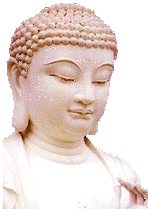
|
|

-
Mindful Therapy
By
Lisa Liddane, ORANGE COUNTY REGISTER,
- Jan 27,
2004
- --o0o--
- Brain scans show how meditation cuts stress
-
-
Orange County, Calif. (USA)
-- IN THE MIDDLE of the night,
Dale
Lechtman
wakes up, all kinds of thoughts crowding sleep out of her mind. But
Lechtman uses meditation to handle insomnia.
-
Lying in bed,
she focuses on breathing. She takes in air deeply. Then, she expels it
through her nose and mouth slowly, as though she were trying to make a
feather float on her breath.
-
Thoughts
relentlessly pound at her mind's door, but in time, they are no match
for Lechtman's skills. They disintegrate harmlessly into darkness,
and, finally, the 62-year-old nurse from
Westminster
is relaxed enough to resume sleeping.
-
Lechtman has
found that secular meditation -- the deliberate quieting and focusing
of the mind and body -- can be beneficial to her health.
-
As patients
and doctors seek answers other than medications to treat illnesses,
some are finding that meditation can be strong medicine.
-
More doctors
have opened their minds to the idea of meditation as complementary
therapy as more studies emerge linking better health and meditation,
said Dr. Roger Walsh, professor of psychiatry at UC Irvine.
Walsh
has published research on meditation and teaches the practice as an
elective to medical students.
-
Among the
latest findings:
-
• A pilot
study led by Walsh suggested that meditation is useful in
understanding the effects of antidepressants and might be useful as
maintenance therapy for depression.
-
Researchers
found that meditation -- like antidepressants -- fostered a state of
equanimity.
-
This is the
ability to tolerate and not be disturbed by potentially provocative or
stimulating thoughts, events, encounters or experiences. The study
appeared recently in the Journal of Mental and Nervous Disorders.
-
• A study
presented at a recent American Heart Association meeting found that
transcendental meditation, or TM, reduced the severity of risk factors
in metabolic syndrome.
-
This syndrome
is a collection of conditions that lead to heart disease, such as high
blood pressure and increased blood-sugar levels.
-
People who
practiced TM significantly decreased their levels of blood pressure,
blood sugar and insulin, said
Dr.
Noel
Bairey
Merz,
study author and medical director of the Preventive and
Rehabilitative
Cardiac
Center at Cedars-Sinai Medical Center in Los Angeles. Merz continues
to study the effect of meditation on heart disease.
-
• Preliminary
results of a study on meditation and binge-eating disorder showed that
meditation can help people "reconnect" with their mind and body to
understand when to eat and when to stop.
-
Mindfulness
meditation can help those with the disorder gain control over their
eating habits, said Jean Kristeller, professor of psychology and
director of the Center for the Study of Health, Religion and
Spirituality at Indiana State University.
-
This research
joins an increasing body of knowledge based on science rather than on
religious beliefs, whether rooted in Buddhism or Christianity.
Religious elements can be present in meditation, but it's also
possible to practice meditation without them.
-
Some
meditators in hospital settings say the turning point for meditation
in medical practice came after 1975, when
Harvard
University
researcher Dr. Herbert Benson first wrote about the value of
meditation in treating illnesses in the book "The Relaxation
Response."
-
Meditation
already is an essential part of the
Dr.
Dean
Ornish program for reversing heart disease, which impressed Lechtman
and her husband, Max.
-
This year, the
Lechtmans took weekly beginner meditation classes taught by Martha
Jensen at UC Irvine. In these classes, Jensen teaches a range of
meditation techniques in sets of four weekly sessions.
-
Meditation
practitioner Cheryl Medicine Song-Procaccini also introduces
participants to various meditation techniques in monthly classes at
the Cordelia Knott Center for Wellness in Orange, which is affiliated
with the oncology and breast centers of St. Joseph Hospital.
-
At Mission
Hospital in Mission Viejo, meditation is part of a stress-management
program offered by the hospital's cardiac rehab services.
-
People with
medical conditions such as cancer or heart diseases take the classes,
as well as those who want to deal with stress, according to
Jensen
and Procaccini.
-
"Everything we
learn in the meditation chair we can use in everyday life," Procaccini
said. "As we strengthen our concentration, we become less reactive to
what's happening to everything outside of ourselves."
-
It's important
for beginners to be exposed to different types of meditation to find
one that's right for them, Jensen said.
-
One person may
find walking meditation effective, while another may prefer to use a
mandala, a symbol upon which one concentrates. Some choose to chant a
mantra or repeat a prayer or word, such as peace or calm.
-
A common
mistake some novices make is to try a type of meditation and not like
it, then give up without experimenting with other ways.
-
Not
surprisingly, time -- not motivation -- is the biggest obstacle to
maintaining the practice of meditation, said
Dr.
Wadie
Najm, associate professor of family medicine at UC Irvine. Longtime
practitioners recommend meditating twice a day for 20 minutes each
time. "It's not as quick as taking medication," said Najm, who has
recommended meditation to some patients. It requires a time
commitment, much as exercise does.
-
Sometimes,
meditation helps the body and mind so much that patients can reduce
their dosage of medications, such as drugs to reduce blood pressure or
stress and anxiety, Najm said. In a few cases, meditation has proved
so effective that it picks up where medication leaves off.
-
To maintain
the state of equanimity that sometimes results from meditation,
meditators have to continue practicing throughout life. Even longtime
meditators are never completely rid of intrusive thoughts and
distractions but, with practice, are better able to deal with them,
Walsh
said.
-
"The biggest
myth is that if one learns to meditate, one will never feel upset,"
Procaccini said. "Meditation is not about getting rid of difficult
experiences or feelings. It's about learning to cope with them. We
learn to develop a more accepting outlook, with less resistance to
life."
-
HOW TO
MEDITATE
-
There are many
ways to meditate. Here is one to try. If you are unable to complete
this for 20 minutes, do not worry. Relax and do as much as you can:
-
Choose a quiet
place.
-
Sit, as if on
a throne, with dignity and stability. Allow breath to move gently
through your body. Let each breath be like a sigh, bringing calmness
and relaxation.
-
Be aware of
what feels closed and constricted in your body, mind and heart. With
each breath, let space open up those closed-in feelings. Let your mind
expand into space. Open your mind, emotions and senses. Note whatever
feelings, images, sensations and emotions come to you.
-
Each time a
thought carries you away, return to your sense of connection with the
Earth. Feel as if you were sitting on a throne in the heart of your
world. Appreciate moments of stability and peace. Reflect on how
emotions, feelings and stories appear and disappear. Focus on your
body, and rest for a moment in the equanimity and peace.
-
Sit this way
for 10 minutes.
-
Slowly stand
up and take a few steps, walking with the same awareness as when you
were sitting.
-
-- Source:
"The Meditation Year"
-
Source:
http://www.buddhistnews.tv
--o0o--
|
|

